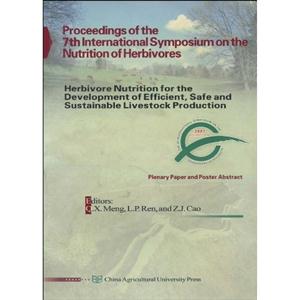第七屆食動物營養(yǎng)國際學(xué)術(shù)研討會論文集 版權(quán)信息
- ISBN:7811172577
- 條形碼:9787811172577 ; 978-7-81117-257-7
- 裝幀:一般膠版紙
- 冊數(shù):暫無
- 重量:暫無
- 所屬分類:>
第七屆食動物營養(yǎng)國際學(xué)術(shù)研討會論文集 本書特色
《第七屆草食動物營養(yǎng)國際學(xué)術(shù)研討會文集》:Proceedings of the,7th International Symposium on the,Nutrition of Herbivores,Herbivore Nutrition for the,Development of Efficient, Safe,and Sustainable Livestock Production.
第七屆食動物營養(yǎng)國際學(xué)術(shù)研討會論文集 內(nèi)容簡介
簡介 《第七屆草食動物營養(yǎng)國際學(xué)術(shù)研討會文集》:proceedings of the,7th international symposium on the,nutrition of herbivores,herbivore nutrition for the,development of efficient, safe,and sustainable livestock production.
第七屆食動物營養(yǎng)國際學(xué)術(shù)研討會論文集 目錄
第七屆食動物營養(yǎng)國際學(xué)術(shù)研討會論文集 節(jié)選
《第七屆草食動物營養(yǎng)國際學(xué)術(shù)研討會文集》 is my pleasure to welcome you to The Seventh International Symposium on the Nutrition of Herbivores (ISNH-7). The objectives of the International AdvisoryCommittee (IAC) are "to provide a forum for development, exchange and promotionof knowledge on the nutrition of terrestrial herbivores in captive and free-livingenvironments". Managing herbivores in commercial and wildlife systems is aboutmore than simply meeting nutrient requirements or manipulating production throughnutrition, important as that is. The meeting traverses a spectrum of research whichadvances the nutritional sciences through novel molecular approaches to problemswhile promoting their application in the management of the productivity and healthof herbivores and the mitigation their impact on the environment. Increasingly, thehuman health benefits and otherwise of animal food products are a consumerconcern and special recognition of the opportunities to enhance food quality throughanimal nutrition is a new feature of the scope of the plenary programme.In the current global environment herbivores, because of their unique digestivesystems, come under intense scrutiny for their "contribution to greenhouse" gases.What often goes unstated is their ability to harvest biomass otherwise unavailable asa human food source without inputs of fossil fuel an attribute which surely securestheir importance for the future well-being of mankind.The breadth of scientific expertise at this conference is a unique feature of theSymposium Series. Make the most of it, and enjoy the kindness and culture of ourhosts.In this volume, you can find the plenary papers and poster abstracts presented atISNH-7. The 6-page short papers have been published in the Journal of Animal Feedand Sciences, as special issue (Volume 16, Supplement 2, 2007).On behalf of the International Advisory Committee, we wish to thank TheChinese Association of Animal Science and Veterinary Medicine (CAAV) fororganizing this symposium in Beijing. The committee members also express theirspecial appreciation to Dr Qingxiang Meng and his colleagues at the ChinaAgricultural University to whom we are indebted for their magnificent work duringthe last 4 years in bringing this scientific programme and conference together. Finally, we wish to thank all the participants at the symposium for theircomments, questions and criticisms. Their input has resulted in significantimprovements in the papers presented in this symposium.
第七屆食動物營養(yǎng)國際學(xué)術(shù)研討會論文集 相關(guān)資料
插圖:The growth rate of yaks generally is not constant from birth to slaughter, especiallyon the Qinghai-Tibet plateau where the annual nutrient supply of grassland variesgreatly with the season. In the first year of the spring-born yaks in Su-Nan County,the BW increased steadily until the first cold season (Figure 3 and Table 17). FromJanuary through May (winter through spring), BW decreased due to the severe coldof the winter/spring season, which produces temperatures that fall below yakthermo-neutrality, and a shortage of forage supply in spring. From May throughOctober (summer through autumn), BW again increased. The ADG of grazing yakduring this warm season was 0.42 kg/d, compared with the 0.25 kg/d reported byXue et al. (1994) for feedlot yak (weighed in morning before feeding) fed ahigh-concentrate diet. Grazing yak thus showed highly efficient compensatorygrowth relative to feedlot yak.Compensatory growth is the term coined by Bohman (1955) to describe theaccelerated or more efficient growth that commonly follows a period of growthrestriction. The effects of a previous plane of nutrition on subsequent growth ofdomestic livestock have been documented extensively (Wilson and Osbourn, 1960;Allden, 1970; Moran and Holmes, 1978). The phenomenon of compensatory growthis of considerable practical significance to grassland livestock production. Theefficacy of compensatory growth in a segmented production system is based on thedifferences in market value and growth efficiency between compensating andnon-compensating animals. In an integrated yak production system such as that onthe Qinghai-Tibet Plateau, actual input costs for each phase of production should beconsidered. Our data documenting the BW loss in grazing yak in the cold seasondemonstrated that the decline in BW during the first weight loss season consumed25.7% of the total BW accumulation of the first (preceding)
- >
推拿
- >
苦雨齋序跋文-周作人自編集
- >
有舍有得是人生
- >
中國人在烏蘇里邊疆區(qū):歷史與人類學(xué)概述
- >
企鵝口袋書系列·偉大的思想20:論自然選擇(英漢雙語)
- >
姑媽的寶刀
- >
李白與唐代文化
- >
月亮與六便士

















